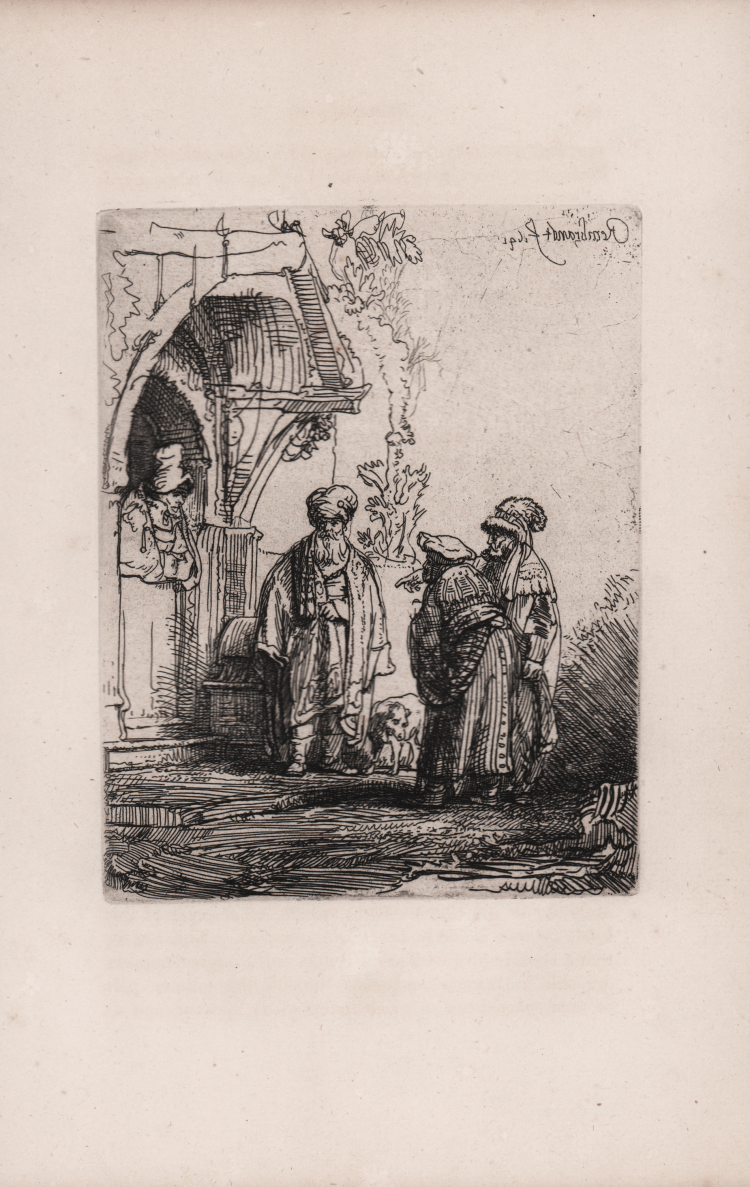




| Reference: | S42100 |
| Author | Harmensz van Rijn detto REMBRANDT |
| Year: | 1641 ca. |
| Measures: | 115 x 145 mm |



| Reference: | S42100 |
| Author | Harmensz van Rijn detto REMBRANDT |
| Year: | 1641 ca. |
| Measures: | 115 x 145 mm |
Etching, signed and dated, upper right, in reverse: Rembrandt f 1641. Second state, of two.
Example from the Etching and Etchers by Philip Gilbert Hamerton, London, McMillan & Co., 1868.
Magnificent proof, printed on laid paper with margins, in excellent condition.
One of the principal proponents of the nineteenth-century etching revival in England, Hamerton published this treatise on the medium that also featured the primary contemporary and historical practitioners. He took pride in offering his readers an impression from an original Rembrandt plate printed by the Parisian etching specialist Auguste Delâtre. The author explains having to choose an obscure plate for the purpose, as the best-known subjects had by then been worn down to the point that their lines retained little ink and they printed "ghosts."
|
Hind. 183.ii; B.118; Hollstein XVIII.62; Bartsch, 118.ii; New Hollstein (Rembrandt).II.68.190 ii/ii.
|
Harmensz van Rijn detto REMBRANDT (Leida 1606 - Amsterdam 1669)
|
Born in Leiden, Holland in 1606, Rembrandt studied with Jacob Isaacsz van Swanenburgh (1571-1638) and Pieter Lastman (1583-1633). By 1626 he was an independent painter, working in Leiden alongside Jan Lievens (1607-74), another pupil of Lastman.
In 1631 Rembrandt moved to Amsterdam where he painted portraits of wealthy merchants. Three years later, he married his first wife, Saskia, and by the end of the 1630s he had moved into a substantial house (now the Rembrandt House Museum). In 1642, the year Rembrandt completed The Nightwatch (Rijksmuseum, Amsterdam), Saskia died.
By 1649, Hendrikje Stoffels had become his housekeeper and partner. Both Saskia and Hendrikje Stoffels posed for many paintings and sketches, often appearing as Susannah, Diana, Flora, Artemisa and other classical or Biblical figures. Rembrandt, however, was plagued by financial troubles and in 1656 his assets were made over to the courts, and many were sold. With his wife and son in financial control, Rembrandt continued to paint. Hendrikje died in 1663, his son Titus in 1668 and Rembrandt himself in 1669.
In his drawings, etchings and paintings, Rembrandt treated every subject: histories, landscapes, portraits, self-portraits, everyday scenes or sketches from nature. Rembrandt's biographer, Cornelis de Bie, praised his paintings, 'which enlighten every mind', and his etchings which are 'the very soul of life that lives therein'.
|
|
Hind. 183.ii; B.118; Hollstein XVIII.62; Bartsch, 118.ii; New Hollstein (Rembrandt).II.68.190 ii/ii.
|
Harmensz van Rijn detto REMBRANDT (Leida 1606 - Amsterdam 1669)
|
Born in Leiden, Holland in 1606, Rembrandt studied with Jacob Isaacsz van Swanenburgh (1571-1638) and Pieter Lastman (1583-1633). By 1626 he was an independent painter, working in Leiden alongside Jan Lievens (1607-74), another pupil of Lastman.
In 1631 Rembrandt moved to Amsterdam where he painted portraits of wealthy merchants. Three years later, he married his first wife, Saskia, and by the end of the 1630s he had moved into a substantial house (now the Rembrandt House Museum). In 1642, the year Rembrandt completed The Nightwatch (Rijksmuseum, Amsterdam), Saskia died.
By 1649, Hendrikje Stoffels had become his housekeeper and partner. Both Saskia and Hendrikje Stoffels posed for many paintings and sketches, often appearing as Susannah, Diana, Flora, Artemisa and other classical or Biblical figures. Rembrandt, however, was plagued by financial troubles and in 1656 his assets were made over to the courts, and many were sold. With his wife and son in financial control, Rembrandt continued to paint. Hendrikje died in 1663, his son Titus in 1668 and Rembrandt himself in 1669.
In his drawings, etchings and paintings, Rembrandt treated every subject: histories, landscapes, portraits, self-portraits, everyday scenes or sketches from nature. Rembrandt's biographer, Cornelis de Bie, praised his paintings, 'which enlighten every mind', and his etchings which are 'the very soul of life that lives therein'.
|